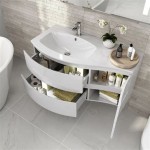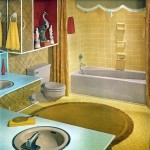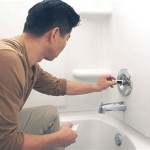How To Clean Bathroom Mirrors: A Comprehensive Guide
Bathroom mirrors, frequently subjected to splashes of water, toothpaste splatters, hairspray residue, and streaks, require regular cleaning to maintain clarity and shine. Neglecting the mirror's surface can lead to a buildup of grime that obscures reflection and diminishes the overall aesthetic appeal of the bathroom. This article provides a comprehensive guide to effectively clean bathroom mirrors, outlining various methods and techniques to achieve a streak-free, sparkling finish.
The frequency of cleaning bathroom mirrors depends on usage and the level of humidity in the bathroom. High-traffic bathrooms may require cleaning several times a week, while less frequented bathrooms can be cleaned weekly or bi-weekly. Regular cleaning not only improves visibility but also prevents the accumulation of stubborn stains that become increasingly difficult to remove over time.
Before initiating any cleaning process, it is imperative to gather the necessary supplies and tools. Appropriate preparation ensures efficiency and minimizes the risk of damaging the mirror surface. Essential items typically include a spray bottle, microfiber cloths, cleaning solutions (commercially available or homemade), and optionally, a squeegee.
Microfiber cloths are highly recommended for cleaning mirrors as they possess the ability to lift dirt and grime without leaving behind lint or streaks. Avoid using paper towels, which can often leave behind fibers that detract from the mirror's clarity. A clean, dry microfiber cloth is crucial for the final buffing stage to achieve a polished appearance.
Selecting the appropriate cleaning solution is also a key step. There are numerous commercially available glass cleaners specifically formulated for mirrors. These products often contain ingredients that break down grease and prevent streaking. However, cost-effective and environmentally friendly homemade solutions can be equally effective.
Utilizing Commercial Glass Cleaners
Commercial glass cleaners offer a convenient and readily available option for cleaning bathroom mirrors. These products are typically designed to dissolve grime, remove water spots, and leave behind a streak-free shine. When using a commercial glass cleaner, it is crucial to follow the manufacturer's instructions to ensure optimal results and prevent potential damage to the mirror or surrounding surfaces.
To apply commercial glass cleaner effectively, spray a light mist onto the mirror's surface, ensuring even coverage. Avoid oversaturating the mirror, as excess liquid can drip down and potentially damage the surrounding wall or vanity. After spraying, immediately wipe the surface with a clean, dry microfiber cloth using overlapping strokes.
For stubborn stains or areas with heavy buildup, it may be necessary to apply the cleaner and allow it to dwell for a few minutes before wiping. This allows the cleaning solution to penetrate the grime and loosen it, making it easier to remove. In such cases, it is essential to avoid allowing the cleaner to dry completely on the mirror surface, as this can lead to streaking.
After wiping the entire mirror surface with a damp microfiber cloth, use a clean, dry microfiber cloth to buff the mirror to a streak-free shine. This final buffing step is crucial for achieving the desired clarity and brilliance. The use of a squeegee can also aid in streak-free drying, especially for larger mirrors.
Preparing Homemade Cleaning Solutions
Homemade cleaning solutions offer an environmentally friendly and cost-effective alternative to commercial glass cleaners. Several readily available household ingredients can be combined to create effective mirror cleaning solutions. Common options include vinegar, ammonia, rubbing alcohol, and dish soap.
A simple and widely used homemade solution consists of a mixture of equal parts white vinegar and water. Vinegar's acidity helps to cut through grease and dissolve mineral deposits, making it an effective cleaner for bathroom mirrors. To prepare this solution, combine equal parts white vinegar and distilled water in a spray bottle.
Another effective homemade solution involves using rubbing alcohol. Combine one part rubbing alcohol with three parts water in a spray bottle. Rubbing alcohol evaporates quickly, reducing the likelihood of streaking. This solution is particularly useful for removing hairspray residue and other sticky substances from the mirror surface.
A mild solution of dish soap and water can also be used to clean bathroom mirrors. Add a few drops of dish soap to a spray bottle filled with water. Shake gently to mix the solution. It is important to use only a small amount of dish soap, as excessive soap can leave behind a residue that is difficult to remove. Ensure the dish soap used is clear and free of dyes or fragrances.
When using any homemade cleaning solution, it is crucial to test it on an inconspicuous area of the mirror first to ensure that it does not damage the surface. This is particularly important for antique mirrors or mirrors with delicate frames. If the solution appears to be safe, proceed to clean the entire mirror surface.
Effective Cleaning Techniques
Regardless of the chosen cleaning solution, employing proper cleaning techniques is essential for achieving optimal results. The following techniques are recommended for cleaning bathroom mirrors effectively and efficiently.
Begin by pre-cleaning the mirror surface to remove any loose debris or dust. This can be accomplished by gently wiping the mirror with a clean, dry microfiber cloth. Removing loose particles beforehand prevents them from being smeared across the surface during the cleaning process, which can lead to scratches or streaks.
Apply the cleaning solution sparingly to the mirror surface. Avoid oversaturating the mirror, as excess liquid can seep behind the mirror and damage the wall or vanity. A light mist is typically sufficient to cover the entire surface. If necessary, apply a second light mist to areas with heavy buildup or stubborn stains.
Wipe the mirror surface with a clean, damp microfiber cloth using overlapping strokes. Start at the top of the mirror and work your way down, ensuring that each section is thoroughly cleaned. Avoid using circular motions, as they can sometimes leave behind streaks. Instead, use vertical or horizontal strokes to achieve a more uniform finish.
For stubborn stains or areas with heavy buildup, allow the cleaning solution to dwell on the surface for a few minutes before wiping. This allows the solution to penetrate the grime and loosen it, making it easier to remove. After allowing the solution to dwell, gently scrub the area with a clean, damp microfiber cloth.
After wiping the entire mirror surface with a damp microfiber cloth, use a clean, dry microfiber cloth to buff the mirror to a streak-free shine. This final buffing step is crucial for achieving the desired clarity and brilliance. The use of a squeegee can also aid in streak-free drying, especially for larger mirrors. Overlap each stroke of the squeegee slightly to prevent streaks.
Pay particular attention to the edges of the mirror, as these areas are often overlooked and can accumulate dirt and grime. Use a cotton swab or a corner of a microfiber cloth to clean the edges of the mirror thoroughly. Be careful not to apply excessive pressure, as this can damage the mirror's frame or sealant.
If streaks persist after cleaning, try using a dry portion of the microfiber cloth to buff the affected areas. Sometimes, streaks are caused by residual moisture or cleaning solution. Buffing with a dry cloth can help to remove these residues and achieve a streak-free finish.
For mirrors with decorative frames, be sure to clean the frame as well. Use a separate cleaning solution and cloth that are appropriate for the frame material. Avoid getting cleaning solution on the mirror's surface while cleaning the frame.
After cleaning the mirror, allow it to dry completely before using it. This will help to prevent water spots and streaks from forming. If desired, you can use a dry microfiber cloth to speed up the drying process.
By following these techniques, it is possible to achieve a sparkling, streak-free bathroom mirror that enhances the overall appearance of the bathroom.

How To Clean Mirrors In The Bathroom Radiant Cleaning Service

How To Clean Mirrors Maids By Trade

Clean Mirrors Without Streaking Bond Cleaning In Adelaide

Mirror Cleaning Tips Best Methods For Bathroom Mirrors Tiktok

How To Clean A Mirror Like Professional Cleaner

How To Clean A Bathroom Mirror

How To Clean Bathroom Mirror Stains A Complete Guide
.webp?strip=all)
How To Clean A Mirror Molly Maid Cleaning Tips

Easy Cleaning Tips For Your Lighted Bathroom Mirror Hauschenhome

How To Clean Mirrors 29 Ingredient Eliminate Streaks Without Using Contaminants Express Co
Related Posts







